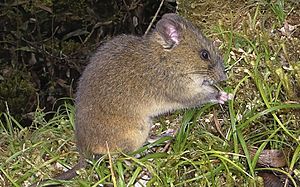Burneo's Oldfield mouse facts for kids
Quick facts for kids Burneo’s Oldfield mouse |
|
|---|---|
 |
|
| Adult female before she was collected on 6 October 2016 (MECN 5259) | |
| Scientific classification | |
| Genus: |
Thomasomys
|
| Species: |
burneoi
|
The Burneo’s Oldfield mouse (Thomasomys burneoi) is a type of rodent that belongs to a group of mice called New World rats and mice. It is part of the Cricetidae family, which includes many different kinds of hamsters, voles, and mice. This special mouse was found in Sangay National Park in the eastern Andes mountains, located in central Ecuador.
This mouse is named after a famous Ecuadorian scientist, Santiago F. Burneo. He is a mammalogist, which means he studies mammals. The mouse was officially described by scientists Lee, Tinoco, and Brito in 2022.
About Burneo's Oldfield Mouse
Burneo's Oldfield mouse is a newly discovered species. It is part of the Thomasomys genus, which includes many different kinds of mice found in the Andes mountains. These mice are often called "oldfield mice" because they live in open, grassy areas, similar to old fields.
Scientists study these mice to learn more about biodiversity. Finding new species like the Burneo's Oldfield mouse helps us understand how many different types of animals live on Earth. It also helps us protect their homes.
Where Does It Live?
The Burneo's Oldfield mouse lives in the high Andes mountains. Specifically, it was found in Sangay National Park in Ecuador. This park is a very important natural area. It has tall mountains, volcanoes, and many different kinds of forests.
The park is a World Heritage Site, meaning it is recognized globally for its natural importance. Animals like the Burneo's Oldfield mouse need places like Sangay National Park to survive. These areas provide them with food, shelter, and safety.
How Was It Discovered?
Scientists discovered the Burneo's Oldfield mouse during a research trip. They were exploring the forests of Sangay National Park. When they found this mouse, they carefully studied its features. They compared it to other known mouse species.
After detailed research, they confirmed it was a completely new species. This discovery shows that there are still many unknown animals in the world. It also highlights the importance of exploring and protecting natural habitats.
See also
- List of mammals of Ecuador
 In Spanish: Ratón de Burneo para niños
In Spanish: Ratón de Burneo para niños

